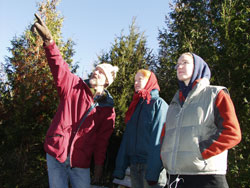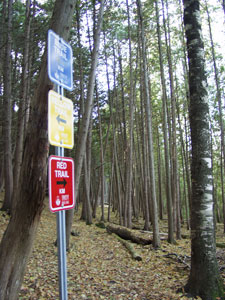
| Daily News | News Releases | Special Bulletins | Daily News Archives |
| The View from Trent | Trent Magazine | Focus Trent | Build 2000 |
The nature of hands-on learning
 Aristotle,
who is quoted as saying "what we have to learn to do, we learn by
doing," would assuredly have been proud if he had witnessed a recent
field trip involving four students from ERS 467.
Aristotle,
who is quoted as saying "what we have to learn to do, we learn by
doing," would assuredly have been proud if he had witnessed a recent
field trip involving four students from ERS 467.
The Aristotelian hands-on philosophy of education came to life on Thursday, November 7, as professor emeritus Roger Jones led a field trip through Trent’s Wildlife Sanctuary Nature Area, located on a large tract of land south of Mackenzie House. The purpose of the excursion was to examine the property and look for revealing clues about the history of the land.
The four students involved – Sarah Wannaker, Jennifer Jago, Meredith Carter and Amanda Pruner – are enrolled in an environmental history reading course supervised by ERS Professor Stephen Bocking. The course examines change in environmental use and in ideas of the environment, over time. The Wildlife Sanctuary property provided the opportunity to visibly and tangibly assess land use history.
Prompted by Prof. Jones, the students looked at patterns of plant growth and used plant/tree identification to determine the legacy of the land. Clues such as the prolific presence of goldenrod, asters, European Buckthorn, White Cedars and Black Locust trees were evidence of old field succession, which indicates farm use. Prof. Jones confirmed that, indeed, much of the property had been cleared in the early- and mid-1800s, and that farm activity came to end in the late 1960s after Trent acquired the property. Certain trees that were left along fencelines influenced new growth and propagated their own species and some invasive species, such as European Buckthorn, have proliferated in the area because of the availability of open land.
 Some
old foundations and capped wells on the property indicate locations of
former farm houses, and garden plants, such as rhubarb and lilacs, grow
in old garden plots during appropriate seasons.
Some
old foundations and capped wells on the property indicate locations of
former farm houses, and garden plants, such as rhubarb and lilacs, grow
in old garden plots during appropriate seasons.
Throughout the walk, Prof. Jones pointed out many interesting plants and geographic features. He shared information about identifying trees and provided some background about the development of the Wildlife Sanctuary.
Prof. Stephen Bocking, the supervisor of ERS 467, was pleased with the field trip and says it demonstrates an enriched method of learning. "The students really enjoyed it and felt it was worthwhile," says Prof. Bocking. "I think Roger did an excellent job of showing the students the kinds of evidence available in nature, related to history. In this course we’ve been looking at primary texts and historical documents, so to go out in the field and study the traces of bygone gardens and other things was essential. It reminds us that the history is all around us, even in a nature area that seems to be just abandoned fields."
Photo 1: Professor emeritus Roger Jones points out European Buckthorn growth to fourth-year students Jennifer Jago and Sarah Wannamaker during a recent field trip to the Wildlife Sanctuary.
Photo 2: Signage was improved in the Wildlife Sanctuary this past summer, making it easier to identify specific trails.
Back to Trent's Daily News
![]() Return to Trent Home
Return to Trent Home
Maintained by the Communications Office.
Last updated
November 25, 2002